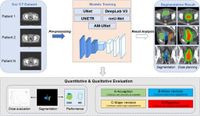A novel deep learning model for precise cancer treatment planning has been developed, demonstrating potential to revolutionize brachytherapy for cervical cancer patients. Dubbed the Automatic Segmentation Model based on Mamba Framework or AM-UNet, this pioneering technology streamlines the delineation of high-risk clinical target volumes (HRCTV) and organs at risk (OARs), significantly enhancing workflow efficiency.
Utilizing a dataset of 645 CT scans from 179 cervical cancer patients treated at the Fujian Cancer Hospital between 2006 and 2020, researchers evaluated the performance of AM-UNet against four other models: UNet, DeepLab V3, UNETR, and nnU-Net. The results were striking. AM-UNet achieved impressive mean Dice similarity coefficients (DSCs) of 0.862 for HRCTV, 0.937 for bladder, 0.823 for rectum, and 0.725 for sigmoid. Subjective assessments rated 93.07% of AM-UNet's delineated HRCTV as clinically acceptable or in need of only minor adjustments, underscoring its promising efficacy in a clinical setting.
Brachytherapy plays a critical role in treating cervical cancer; however, the intricate task of accurately delineating target volumes and OARs has traditionally been labor-intensive and inconsistent. As the authors of the article noted, there exists notable subjectivity in current methods, leading to significant inter-observer and intra-observer variability. With conventional techniques often falling short due to their complexity, the need for automation becomes paramount not only for improved precision but also for the sustainability of clinical workflows.
The AM-UNet model's design is inspired by the Mamba architecture, which elegantly integrates convolutional neural networks (CNNs) with a mechanism for enhanced long-range dependency modeling akin to Transformers. This hybrid approach eliminates the computational inefficiencies often found in traditional CNNs while addressing the local focus issues within medical image segmentation. According to the study, Mamba-based architectures are proving effective for various tumor radiotherapy applications.
The study received approval from the Ethics Committee of Fujian Cancer Hospital, and at its core highlighted that AM-UNet requires only an average of five seconds for segmentation tasks. In stark contrast, manual contouring typically demands between 90 to 120 minutes per patient. This dramatic reduction in time not only underscores AM-UNet's efficiency but also its potential to alleviate the burden on radiation oncologists in time-critical environments.
Quantitative assessments revealed that the dosimetric differences between contours generated by AM-UNet and those delineated manually were less than 1%, indicating a high degree of congruence in the treatment planning stage. As noted by the authors, "the dosimetric differences highlight its potential for improving clinical workflows in brachytherapy." This is particularly pertinent considering the importance of accurately confining radiation doses to HRCTV while minimizing exposure to surrounding healthy tissues.
Despite the advancements, the study acknowledged that certain differences exist, particularly in the contours for the sigmoid, which proved challenging due to its complex anatomy. Nevertheless, AM-UNet still managed to outperform other models in both quantitative and qualitative assessments. This effectiveness positions AM-UNet as a leading candidate for clinical application, paving the way for future investigations aimed at refining automatic segmentation processes in other cancer types.
Looking ahead, further validation across multiple clinical centers will be crucial for establishing the generalizability and robustness of the AM-UNet model. Additionally, the exploration of this approach's application to different forms of cancer and imaging modalities, such as MRI, represents an exciting horizon for future research endeavors. The authors concluded that, while the results are promising, the continuous evolution of segmentation models will be necessary to overcome remaining challenges, particularly in ensuring comprehensive performance across all target structures.
Ultimately, AM-UNet stands as a significant breakthrough in the field of oncology, particularly for the treatment of cervical cancer. With its potential to drastically improve workflow efficiency and segmentation accuracy, this technology heralds a new era in brachytherapy, significantly impacting patient outcomes and therapeutic strategies.




